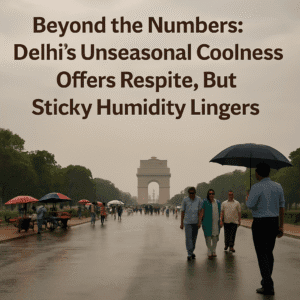Beyond the Numbers: Delhi’s Unseasonal Coolness Offers Respite, But Sticky Humidity Lingers
Delhi experienced a welcome, unseasonal respite from peak summer heat on Monday, with a maximum temperature settling at a notably mild 33.4°C – significantly cooler than typical August scorchers. While the lower temperatures offered tangible relief, reducing strain on infrastructure and making outdoors briefly more bearable, high humidity levels of 68% created a persistently sticky and oppressive feel.
The India Meteorological Department forecasts this pattern to continue, predicting generally cloudy skies with moderate rain and possible thunderstorms for Tuesday, keeping maximums around 32°C and minimums near 25°C. This monsoon-influenced weather brings the crucial benefit of cooler air but also ensures high humidity lingers, making comfort elusive and increasing risks of travel disruption and slippery conditions from rain.
Air quality remained in the ‘moderate’ zone (AQI 116), a relative positive aided by the rain, though sensitive groups should still exercise caution. For residents, it’s a period of humid relief – a chance for cooler moments without air conditioning, yet constantly accompanied by dampness and the need for umbrellas. It represents a tricky balance: vital rain washing away extreme heat and some pollution, but bringing its own challenges of mugginess and unpredictability. Enjoy the break from the furnace, but brace for the moisture-laden air and sudden downpours.

Beyond the Numbers: Delhi’s Unseasonal Coolness Offers Respite, But Sticky Humidity Lingers
While much of India bakes in peak summer heat, Delhi experienced a surprisingly temperate Monday, offering residents a welcome – if slightly muggy – break from typical August scorchers. Here’s what the weather data really means for life in the capital:
- The Temperature Reprieve: A maximum of 33.4°C is significantly below Delhi’s usual August highs, which often soar above 38°C or even 40°C. This isn’t just a number; it translates to tangible relief – less strain on power grids from AC use, slightly easier commutes, and outdoor activities becoming briefly more bearable. The minimum of 27.2°C, slightly below normal, also meant marginally more comfortable nights for many.
- The Humidity Hustle: Don’t be fooled by the “moderate” temperature. The 68% humidity recorded in the late afternoon is the critical factor. This creates that characteristic sticky, oppressive feel Delhi is known for in the monsoon. The air feels thick, sweat doesn’t evaporate easily, and even 33°C can feel significantly warmer and more draining physically. It’s not the heat, it’s the humidity – truly.
- The Monsoon’s Mixed Blessing: The India Meteorological Department’s (IMD) prediction of continued cloudiness, moderate rain, and thunderstorms (with Tuesday’s forecast at max 32°C / min 25°C) confirms the monsoon’s grip. While the rain brings crucial respite from extreme heat and dust, it also means:
- Humidity remains high: Expect that sticky feeling to persist.
- Travel disruptions: Thunderstorms and moderate rain can lead to waterlogging, traffic snarls, and potential delays.
- A Slippery City: Pavements and roads become hazardous.
- Air Quality: A Moderate Note: The AQI of 116 (“Moderate”) is a relatively positive note for Delhi. While not ideal, it’s far better than the “Very Poor” or “Severe” categories common in winter. The ongoing rains likely helped wash away some pollutants, providing slightly cleaner air to breathe alongside the cooler temperatures. However, sensitive groups should still remain cautious.
The Human Experience:
For Delhiites, this weather represents a brief, humid pause in the city’s intense heat cycle. It’s a chance to enjoy slightly cooler mornings and evenings, perhaps even turning off the AC for a few hours. Parks see more visitors in the late afternoon, and street vendors might get a slightly longer window of business.
Yet, the high humidity ensures it’s far from perfect comfort. Clothes stick, energy levels dip, and the constant threat of a downpour or thunderstorm requires carrying umbrellas and planning for potential delays. The dampness can also exacerbate issues for those with respiratory or joint problems.
Looking Ahead:
The IMD forecast suggests this pattern – cooler-than-usual temperatures, high humidity, and regular rain/thunderstorms – will continue for the immediate future. While the heatwave fury is absent, Delhi’s monsoon experience is defined by this muggy, unpredictable, yet vital weather. Enjoy the respite from the blistering heat, but keep your rain gear handy and be prepared for the humidity’s embrace. The city breathes a little easier, albeit a damp breath.
You must be logged in to post a comment.